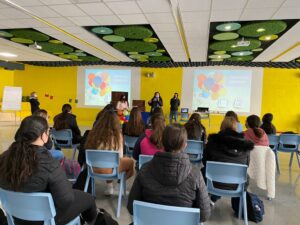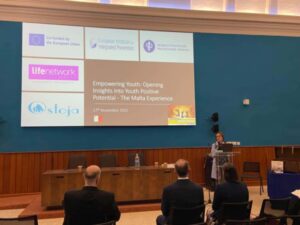ERASMUS / AOT Programme & Conference





Our project’s aim was to disseminate the integrated prevention programme across all the participating countries, by involving schools, parents, teachers and religious leaders. The Programme, entitled the Archipelago of Treasures (AOT), had already been introduced in Polish schools. It was known that participants perceived the AOT Programme as a highly effective tool in preventing youth problems. During the project, the AOT Programme was offered to 14 to 15-year-old students across the three participating countries.



About the Project
Our project’s aim was to disseminate the integrated prevention programme across all the participating countries, by involving schools, parents, teachers and religious leaders. The Programme, entitled the Archipelago of Treasures (AOT), had already been introduced in Polish schools. It was known that participants perceived the AOT Programme as a highly effective tool in preventing youth problems. During the project, the AOT Programme was offered to 14 to 15-year-old students across the three participating countries.
The Archipelago of Treasures was conceived as a suitable aid for youth in preparing them for ‘the journey of life’. The AOT Programme describes the youth’s pursuit for a meaningful life in the following way: a conscious effort to strive for the most important life goals, to realise their life-vocation and to fulfil their deepest dreams.
The intention of the project is to contribute to preventing such social maladies as early school leaving, mental health difficulties, susceptibility to mental health problems, behavioural problems etc.
Research was conducted to identify youth’s expectations in each of the participating countries. In Malta eleven Public, Church and Private Schools participated in this research with a total of 1222 valid responses. This was done so as to tailor the AOT Programme to the respective needs of the participants.
Several of the EIIP’s surveys and research studies clearly demonstrated that multiple problems and risk behaviours were correlated. They identified a number of common risk factors of youth problems. One of the most important is the sexualisation of the public sphere that has a serious impact on adolescents’ life.
The Archipelago of Treasures Programme is widely perceived as a programme that efficiently counteracts these alarming trends and is able to empower youth, as well as school staff, to meet impending mental breakdowns. The effects of the Programme have been proved by professional evaluation research.
The Archipelago of Treasures (AOT) Programme in Schools
The Archipelago of Treasures® is a vivid and dynamic prevention programme for middle and upper secondary school students. The Archipelago of Treasures® is a registered trademark. The development of the programme, training of the instructors, as well as quality supervision lie in the responsibility of the European Institute for Integrated Prevention.
The Programme can be implemented only by the institutions and trainers who are qualified and licensed by the European Institute for Integrated Prevention (EIIP). Thanks to the Erasmus Funds, the Youth Positive Potential Project, allowed for Life Network Foundation, Ostoja Foundation and Vilniaus Pedagogine Psichologine Tarnyba, to acquire such certification and licence by the EIIP after intense training and support by the same Institute.



Empowering Youth Positive Potential Conference
Three National conferences where organised, in Malta, Lithuania and Poland for the dissemination and exploitation of the research results. The one in Malta was held on the 17th of November 2022, at St. Dominic’s Priory, St. Dominc’s square, Rabat.
Research results of 1222 students from Maltese schools were presented in the conference, together with research results for Poland and Lithuania.
The review of the research report was prepared by Dr. Ewa Siellawa-Kolbowska (PhD), Dr Szymon Grzelak (PhD) and Ms. Agata Balcerzak (MA).



The Results:
- The results were analysed by conducting frequency analyses of the obtained answers and correlation analyses. The type of correlation coefficients was chosen adequately to the scales on which the analysed variables were measured
- As a result of the analyses, it was possible to find links between drinking alcohol, smoking cigarettes, drug use, viewing pornography, early sexual contact, suicidal thoughts and depression
- It was also possible to identify protective factors against engaging in risk behaviours, such as mother and/or father as life guides, being heard in family conversations, religious practices, turning thoughts to God, a good climate in class, acceptance in class, grade average in school, the belief that true love grows over time, belief in true love, and contact with model good marriages
- Risk factors were also identified, such as parental divorce, school truancy, fear of school violence, being in alcohol and drug company, and sexualisation
- The approach in which risk factors are analysed on the one hand, and protective factors on the other, enabled a multifaceted approach to the analysed issues, making it possible to indicate which factors should be eliminated and which should be strengthened in future preventive interventions
- The description of the results of the studies also includes the interpretation of the strength of the relationships between the analysed variables, which made it possible to determine which factors are the most important and key to the occurrence of the analysed risk behaviours and which are less important. Interrelationships between risk factors were also analysed. To ensure the clarity of description, the most important results were appropriately illustrated graphically. The analyses were carried out taking into account an important differentiating factor, which was the sex of the respondents (being a boy or a girl)
- Conclusions from the research made it possible to confirm the successful verification of the integrated prevention model
- The results obtained can provide a very well-founded starting point for further in-depth research, e.g. using standardised tools, which would also enable the analysis of more complex statistical models verified within path analysis or structural modelling.
Detailed Research Reports can be found using the following links: